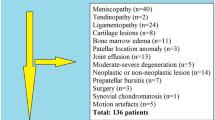Abstract
Purpose
To investigate whether the universally accepted range of normal patellar height ratio derived from MRI for the Insall–Salvati (IS) method could be similarly applied to ultrasound (US).
Materials and methods
This study included 52 patients (age range 11–75 years) who underwent a bi-modality (US and MRI) examination, with a total of 60 knees evaluated. IS index (ratio of the patella tendon length to length of the patella) was acquired with both methods. Two operators, with different experiences of musculoskeletal imaging and blinded to the results of other investigators, separately performed the MRI and US measurements.
Results
For the two operators, MRI reported a mean value of patellar height ratio of 1.10 ± 0.16 (mean ± standard deviation SD), while US a mean value of 1.17 ± 0.16 (mean ± SD). For comparable results, the small addition of 0.16 is needed for the measurements on US compared with MRI. Inter-observer agreements using intra-class correlation coefficient (ICC) was, respectively, 0.97 for MRI and 0.98 for US. The difference of mean values in patellar height ratios between MRI and US was not statistically significant (p = 0.15). The ICC between the two modalities was 0.94.
Conclusion
According to our experience, IS index can be appropriately evaluated on US images, reducing the need of other imaging techniques.


Similar content being viewed by others
References
Ward SR, Terk MR, Powers CM (2007) Patella alta: association with patellofemoral alignment and changes in contact area during weight-bearing. J Bone Joint Surg Am 89:1749–1755
Lenhart RL, Brandon SC, Smith CR et al (2017) Influence of patellar position on the knee extensor mechanism in normal and crouched walking. J Biomech 25(51):1–7
Caton JH, Dejour D (2010) Tibial tubercle osteotomy in patello-femoral instability and in patellar height abnormality. Int Orthop 34(2):305–912
Insall J, Salvati E (1971) Patella position in the normal knee. Radiology 101(1):101–104
Lee PP, Chalian M, Carrino JA (2012) Multimodality correlations of patellar height measurement on X-ray, CT, and MRI. Skelet Radiol 41(10):1309–1314
Laugharne E, Bali N, Purushothamdas S et al (2016) Variability of measurement of patellofemoral indices with knee flexion and quadriceps contraction: an MRI-based anatomical study. Knee Surg Relat Res 28(4):297–301
Park MS, Chung CY, Lee KM et al (2010) Which is the best method to determine the patellar height in children and adolescents? Clin Orthop Relat Res 468:1344–1351
Diederichs G, Issever AS, Scheffler S (2010) MR imaging of patellar instability: injury patterns and assessment of risk factors. Radiographics 30:961–981
Seil R, Müller B, Georg T et al (2000) Reliability and interobserver variability in radiological patellar height ratios. Knee Surg Sports Traumatol Arthrosc 8(4):231–236
Phillips CL, Silver DAT, Schranz PJ (2010) The measurement of patellar height: a review of the methods of imaging. J Bone Joint Surg 92:1045–1053
Smith TO, Davies L, Toms AP et al (2011) The reliability and validity of radiological assessment for patellar instability. A systematic review and meta-analysis. Skelet Radiol 40:399–414
Lu W, Yang J, Chen S (2016) Abnormal patella height based on Insall–Salvati ratio and its correlation with patellar cartilage lesions: an extremity-dedicated low-field magnetic resonance imaging analysis of 1703 chinese cases. Scand J Surg 105(3):197–203
Munch JL, Sullivan JP, Nguyen JT et al (2016) Patellar articular overlap on MRI is a simple alternative to conventional measurements of patellar height. Orthop J Sports Med 7:2325967116656328
Mohammadinejad P, Shekarchi B (2016) Value of CT scan-assessed tibial tuberosity-trochlear groove distance in identification of patellar instability. Radiol Med 9:729–734
Dei Giudici L, Enea D, Pierdicca L et al (2015) Evaluation of patello-femoral alignment by CT scans: interobserver reliability of several parameters. Radiol Med 11:1031–1042
Solivetti FM, Guerrisi A, Salducca N et al (2016) Appropriateness of knee MRI prescriptions: clinical, economic and technical issues. Radiol Med 4:315–322
Martino F, Ettorre GC, Macarini L et al (1992) Comparative study of echography and conventional radiology in the evaluation of the Insall–Salvati index. Radiol Med 84(6):736–739
Shabshin N, Schweitzer ME, Morrison WB et al (2004) MRI criteria for patella alta and baja. Skelet Radiol 33:445–450
Miller TT, Staron RB, Feldman F (1996) Patellar height on sagittal MR imaging of the knee. AJR Am J Roentgenol 167:339–341
Ali SA, Helmer R, Terk MR (2009) Patella alta: lack of correlation between patellotrochlear cartilage congruence and commonly used patellar height ratios. AJR Am J Roentgenol 193:1361–1366
Author information
Authors and Affiliations
Corresponding author
Ethics declarations
Conflict of interest
The authors declare that they have not conflict of interest.
Ethical approval
All procedures performed in studies involving human participants were in accordance with the ethical standards of the institutional and/or national research committee and with the 1964 Helsinki declaration and its later amendments or comparable ethical standards. This study was approved by the institutional review board.
Rights and permissions
About this article
Cite this article
Giovagnorio, F., Olive, M., Casinelli, A. et al. Comparative US-MRI evaluation of the Insall–Salvati index. Radiol med 122, 761–765 (2017). https://doi.org/10.1007/s11547-017-0781-3
Received:
Accepted:
Published:
Issue Date:
DOI: https://doi.org/10.1007/s11547-017-0781-3




